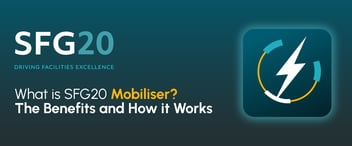
How To Use Facilities-iQ To Tender, Switch Providers & Draft Contracts
Table of Contents
- Connect With Other Active Facilities-iQ License Holders
- How Facilities-iQ Simplifies The Tendering Process
- How Can Maintenance Regimes In Facilities-iQ Be Used In The Tendering Process?
- The Benefits Of Sharing Maintenance Regimes In Facilities-iQ For Tendering
- How Facilities-iQ Can Help You Move Maintenance Providers Without Losing Building Information
- How Facilities-iQ Can Help You Draw Up Compliant Maintenance Contracts
- How Facilities-iQ Can Help You Enforce Contract Penalties
- Understanding Your Responsibilities
Tedious tendering processes, vague contracts and the loss of building maintenance information upon completion can all cause significant disruption and confusion for both Building Owners and Service Providers. Even more worrying are the significant compliance risks - how do you keep your contract aligned with ever-changing legislation?
As the industry standard for building maintenance in the UK since 1990, SFG20 get asked this exact question a lot. The SFG20 standard is used by many organisations to compliance benchmark their contracts and specify works - it’s therefore in everyone’s interests that you can use our standard effectively to tender worry-free.
In this practical guide, you’ll learn how to use SFG20’s latest software solution, Facilities-iQ to effortlessly nail down and enforce a precise specification of works while preventing the loss of building information.
That way, you’ll be able to get exactly what you pay for if you’re a Property Owner and get paid for exactly what you agreed to if you’re a Contractor – it’s a real win-win!
Connect With Other Active Facilities-iQ License Holders Via Our Member List And Digital Badges
Our official Member List provides you with access to a database of active Facilities-iQ license holders, including Contractors and Service Providers and are therefore capable of understanding and executing maintenance works that comply with UK law.
What's more, we now offer Digital Badges to those with an active Facilities-iQ license which can be displayed on their website as concrete proof. This badge is not an image, but rather a live iFrame which means it cannot be copied, modified or deleted.
This Digital Badge is not only available for those with an active license who are bidding on contracts, but also for those who are tendering, helping to connect you with other active license holders.

How Facilities-iQ Simplifies The Tendering Process
By aligning your specification with SFG20, the industry standard for building maintenance, you can be certain that your maintenance plan is keeping your building in optimal condition and legally compliant.
-4.png?width=353&height=353&name=Template-1%20(2)-4.png)
Through our unique Maintenance Regime feature, Facilities-iQ allows parties to draw up and access a precise specification to base a tender on. This can also help you to set KPIs around delivery performance.
When any SFG20 schedule is updated, you'll receive automated notifications for this.
We also allow you to compare the changes side by side and choose when to implement them. This puts you in full control, allowing you to quickly and easily adjust your specification to suit evolving legislation.
The updates will then flow through to your FM (Facility Management) system via our API (Application Programming Interface).
If you’ve tailored a schedule and it's then updated by SFG20, don't worry. Not only are you notified and shown where you are using this schedule, but none of your tailoring will be overwritten by the update.
How Can Maintenance Regimes In Facilities-iQ Be Used In The Tendering Process?
Maintenance Regimes are an exclusive feature to Facilities-iQ. They allow you to define your maintenance strategy by grouping relevant maintenance schedules, meaning you can determine what’s most critical for your organisation and focus on what tasks must be done.
As a result, you may discover that there are fewer tasks to complete and fewer site visits which can save you and your team money.
Our API allows the latest version of your Maintenance Regime to populate into your FM operating systems such as CAFM, meaning no more time-consuming manual updates or falling off the SFG20 standard.
These regimes can then be safely shared with Service Providers who are bidding for the contract via a secure sharing link. Here’s how it works:
- Import your asset register in Facilities-iQ.
- The correct maintenance activities can then be identified for each of your assets
- You can optimise your maintenance strategy by defining which maintenance tasks are appropriate for your building(s).
- Regimes can be shared with Service Providers to allow them to tender for the work.
- Review quotes and choose your preferred supplier.
- The Service Provider who has won your tender can now request a copy of your regime, allowing them to work with the Maintenance Regime you have specified to deliver the maintenance programme.
- You will continue to have the original/master copy of your Maintenance Regime to keep an audit trail of works. This also allows you to continue to review changes to statutory requirements against the maintenance you have specified, and where relevant to collaborate and discuss any changes to maintenance with your contractor.
The Benefits Of Sharing Maintenance Regimes In Facilities-iQ For Tendering
- Supports efficient collaboration and compliance, allowing you to share maintenance task instructions with authorised people and the latest, compliant version of SFG20
- Eliminates wasted time from the Service Provider recreating a regime that already exists
- Removes the risk of human error during the process
- Allows Contractors/Service providers to quote on exactly what’s specified
- Prevents misinterpretation and reduces the risk of not receiving the expected benefits from the project
- Ensures a clear comparison between what is being offered i.e. you can compare quotations on a like-for-like basis
- Allows Service Providers/Contractors to hit the ground running, saving time on both sides
- As Maintenance Regimes are digital, this allows stakeholders to explore and understand your specification in detail, a bonus benefit which paper-based alternatives don’t allow.
How Facilities-iQ Can Help You Move Maintenance Providers Without Losing Building Information 
As you’ve likely experienced, one of the most common issues that arises when moving maintenance providers is the loss of building maintenance information and the subsequent repetitive work that follows, namely providers having to create an asset register from scratch.
The loss of building information is no longer just a matter of frustration, it’s now a legal issue.
Under the Building Safety Act 2022, all buildings that fall within scope must maintain an audit trail of all key details pertaining to a building known as the “Golden Thread”, which includes information such as:
- Details of the assets covered in the contract
- Details of the previous maintenance contract
- Maintenance history including conformity data
Luckily, SFG20 has created a simple yet effective solution to keep all of your information intact during the building handover and make transitioning from one provider to another a million times easier. Here’s how:
- Once the construction team have provided an asset list to either the Building Owner, Service Provider or FM Consultant, a Maintenance Regime can be created using the asset register.
- The Maintenance Regime can then be shared with the Service Provider for completion of works.
- At the end of a contract, Service Providers can simply share Maintenance Regimes back to the Building Owner with all maintenance task IDs retained. When used in tandem with operational systems (e.g. CAFM), this ensures that the Golden Thread of information remains unbroken and is ready to pass on for another tender.
How Facilities-iQ Can Help You Draw Up Compliant Maintenance Contracts
A lot of the time, contracts are created with vague phrasing that leaves interpretation up to the Contractor on what maintenance tasks should be carried out and when.
It may even be the case that your chosen provider hasn’t read the small print, and when this happens, it can lead to huge and potentially costly errors while on the job, not to mention compliance risks. Similarly, if they’re working off a paper-based format of SFG20, it won’t be up to date and therefore no longer compliant.
By making an active Facilities-iQ license mandatory for both Building Owners and Service Providers in all contract agreements, you’ll know they have a clear grasp of their compliance and maintenance responsibilities (i.e. the what, who and when for each individual asset), upholding accountability and mitigating risk for everyone.
How Facilities-iQ Can Help You To Save Money on Contracts-Nov-03-2023-09-58-28-1385-AM.png?width=353&height=243&name=ezgif_com-gif-maker%20(6)-Nov-03-2023-09-58-28-1385-AM.png)
If your contract contains a legally binding agreement to maintain your property to the latest agreed standard of SFG20, then you can use it as a baseline standard to help you to audit against it.
Where a contract specifies a regularly updated standard like SFG20, it is best for contractor relations to agree on a mechanism when the latest update will be adopted by both parties, as there needs to be a conversation where risk best sits for these changes.
Having explicit risk and payment mechanisms stated in your contract makes it clear who is responsible for any financial impacts of the changes. This means that the contractor can reclaim any reasonably foreseen costs rather than factoring a high degree of risk when putting together their bid which leads to paying higher costs where you might not be getting any benefits.
As a client, it's also worthwhile to include penalty clauses as you may be able to retrieve money back where works have not been carried out effectively and indeed in line with legislation.
A customer of ours disclosed to us that thanks to SFG20 he was able to verify and enforce the specifics on an £11m contract and recoup £2m.
Understanding Your Responsibilities
It’s important to note that outsourcing maintenance work does not mean that you can outsource the responsibility or your risk.
Everybody involved from the Building Owner and Facility/Property Manager to the Service Provider/Contractor has their own stringent set of responsibilities as outlined below.
| Building Owner | Facility/Property Manager | Service Provider/Contractor |
|---|---|---|
|
|
|
Discover Frustration-Free Facility Management
Working with third-party providers doesn’t need to be so complicated, time-consuming and expensive.
With Facilities-iQ by your side, you can speed up the tendering process, effortlessly retain information for future building handovers and ensure that everyone involved is staying compliant with the latest version of the SFG20 standard.
We all only have a finite number of hours each day (not to mention only two hands!) - so let us give you back your sanity, time and money with Facilities-iQ, the greatest and latest way to access SFG20, the industry standard for building maintenance since 1990.
If you’re ready to leave the old ways of working behind and be a part of the future of hassle-free and compliant maintenance, book onto one of our interactive Facilities-iQ demo sessions by clicking the button below.






